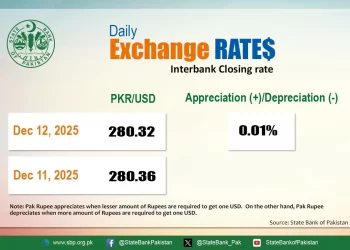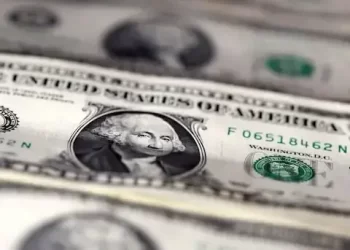SHANGHAI: China’s yuan dipped to a fresh seven-month low against the dollar on Friday, hurt by portfolio outflows from mainland financial markets and speculation the central bank is gradually allowing the currency to weaken.
By 0245 GMT, the yuan was just off a November low of 7.2613, having fallen from 7.2575 earlier in the day. At the lows, it was a mere 7 pips away from the weak side of the band in which the People’s Bank of China manages the currency.
The currency’s drop to 7-month lows in the previous session was triggered in part by a weak central bank fixing rate, which spurred market speculation authorities may be prepared to see it weaken.
But on Friday, in what seemed like efforts to prevent a quicker decline, the PBOC set a slightly stronger mid-point fixing at 7.1196 per dollar, 1,502 points firmer than a Reuters’ estimate.
“It seems that PBOC does not want to have the fix above the 7.12 so soon,” Maybank analysts said in a note. “That sends a signal to markets that they still want to have strong control over the yuan and want to prevent speculative pressure from building against the yuan as well,”.
Spot yuan opened at 7.2575 per dollar and was last trading 2 pips weaker than the previous late session close and 1.98% weaker than the midpoint.
In cash settlement transactions, the yuan was quoted at 7.2621 per dollar, implying it had already hit the weak end of the band in the overnight tenor.
China’s yuan eases to 7-month low after much weaker central bank guidance
The dollar strengthened overnight, its move turning positive for the week, after policy decisions in Europe drew focus to the Federal Reserve’s patient approach to cutting interest rates versus more dovish stances elsewhere.
The yuan has been pressured by its relative low yields versus other currencies against the backdrop of this monetary policy divergence.
Authorities in China continue to stress they have an easing bias to support the broad economy and enable it to achieve a goal of ‘around 5%’ real GDP growth this year.
The yuan is down 2.2% against the dollar so far this year.
It has been on the defensive since early 2023 as China’s economy sputters under pressure from a prolonged property crisis and weak consumption, as falling yields drive capital flows out of yuan, as and foreign investors stay away from its sickly stock market.
Foreign portfolio flows have turned. About 33 billion yuan ($4.54 billion) has left the mainland this month via the Northbound leg of the Stock Connect Scheme, following four months of net inflows.
The Southbound leg also seen 129 billion yuan of outflows from mainland to Hong Kong so far this year.
Ju Wang, head of Greater China FX & rates strategy at BNP Paribas, said the persistent Southbound flows and seasonal dividend flows had led to selling of the offshore yuan and buying of Hong Kong dollars.
“Overall, we expect wide rate differential and a dovish PBOC to sustain the upward pressure on dollar-yuan, but caution against the risk of periodic unwinds of short yuan positions,” Goldman Sachs said in a note.
The offshore yuan traded at 7.2863 yuan per dollar, up about 0.07% in Asian trade.
SHANGHAI: China’s yuan dipped to a fresh seven-month low against the dollar on Friday, hurt by portfolio outflows from mainland financial markets and speculation the central bank is gradually allowing the currency to weaken.
By 0245 GMT, the yuan was just off a November low of 7.2613, having fallen from 7.2575 earlier in the day. At the lows, it was a mere 7 pips away from the weak side of the band in which the People’s Bank of China manages the currency.
The currency’s drop to 7-month lows in the previous session was triggered in part by a weak central bank fixing rate, which spurred market speculation authorities may be prepared to see it weaken.
But on Friday, in what seemed like efforts to prevent a quicker decline, the PBOC set a slightly stronger mid-point fixing at 7.1196 per dollar, 1,502 points firmer than a Reuters’ estimate.
“It seems that PBOC does not want to have the fix above the 7.12 so soon,” Maybank analysts said in a note. “That sends a signal to markets that they still want to have strong control over the yuan and want to prevent speculative pressure from building against the yuan as well,”.
Spot yuan opened at 7.2575 per dollar and was last trading 2 pips weaker than the previous late session close and 1.98% weaker than the midpoint.
In cash settlement transactions, the yuan was quoted at 7.2621 per dollar, implying it had already hit the weak end of the band in the overnight tenor.
China’s yuan eases to 7-month low after much weaker central bank guidance
The dollar strengthened overnight, its move turning positive for the week, after policy decisions in Europe drew focus to the Federal Reserve’s patient approach to cutting interest rates versus more dovish stances elsewhere.
The yuan has been pressured by its relative low yields versus other currencies against the backdrop of this monetary policy divergence.
Authorities in China continue to stress they have an easing bias to support the broad economy and enable it to achieve a goal of ‘around 5%’ real GDP growth this year.
The yuan is down 2.2% against the dollar so far this year.
It has been on the defensive since early 2023 as China’s economy sputters under pressure from a prolonged property crisis and weak consumption, as falling yields drive capital flows out of yuan, as and foreign investors stay away from its sickly stock market.
Foreign portfolio flows have turned. About 33 billion yuan ($4.54 billion) has left the mainland this month via the Northbound leg of the Stock Connect Scheme, following four months of net inflows.
The Southbound leg also seen 129 billion yuan of outflows from mainland to Hong Kong so far this year.
Ju Wang, head of Greater China FX & rates strategy at BNP Paribas, said the persistent Southbound flows and seasonal dividend flows had led to selling of the offshore yuan and buying of Hong Kong dollars.
“Overall, we expect wide rate differential and a dovish PBOC to sustain the upward pressure on dollar-yuan, but caution against the risk of periodic unwinds of short yuan positions,” Goldman Sachs said in a note.
The offshore yuan traded at 7.2863 yuan per dollar, up about 0.07% in Asian trade.









